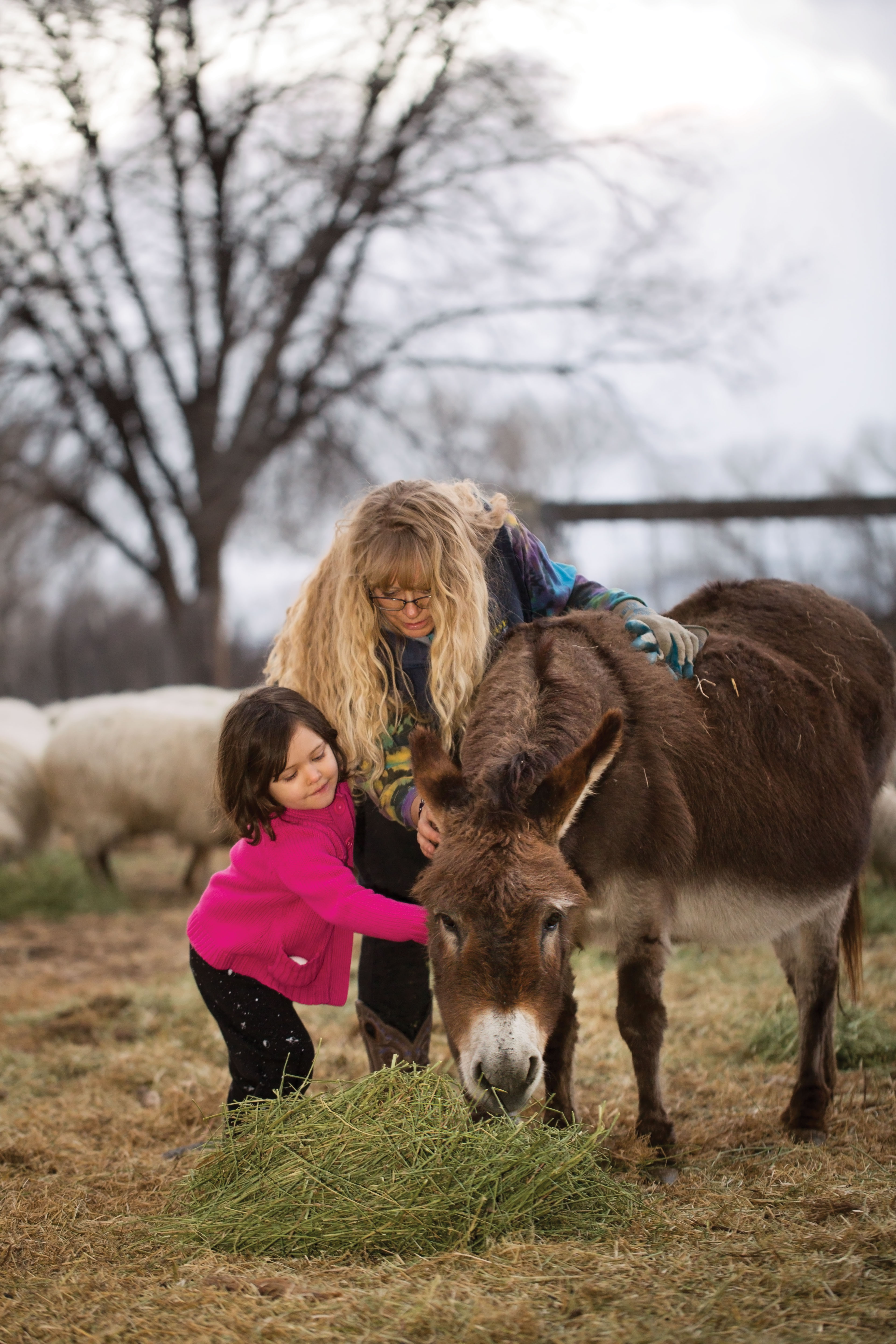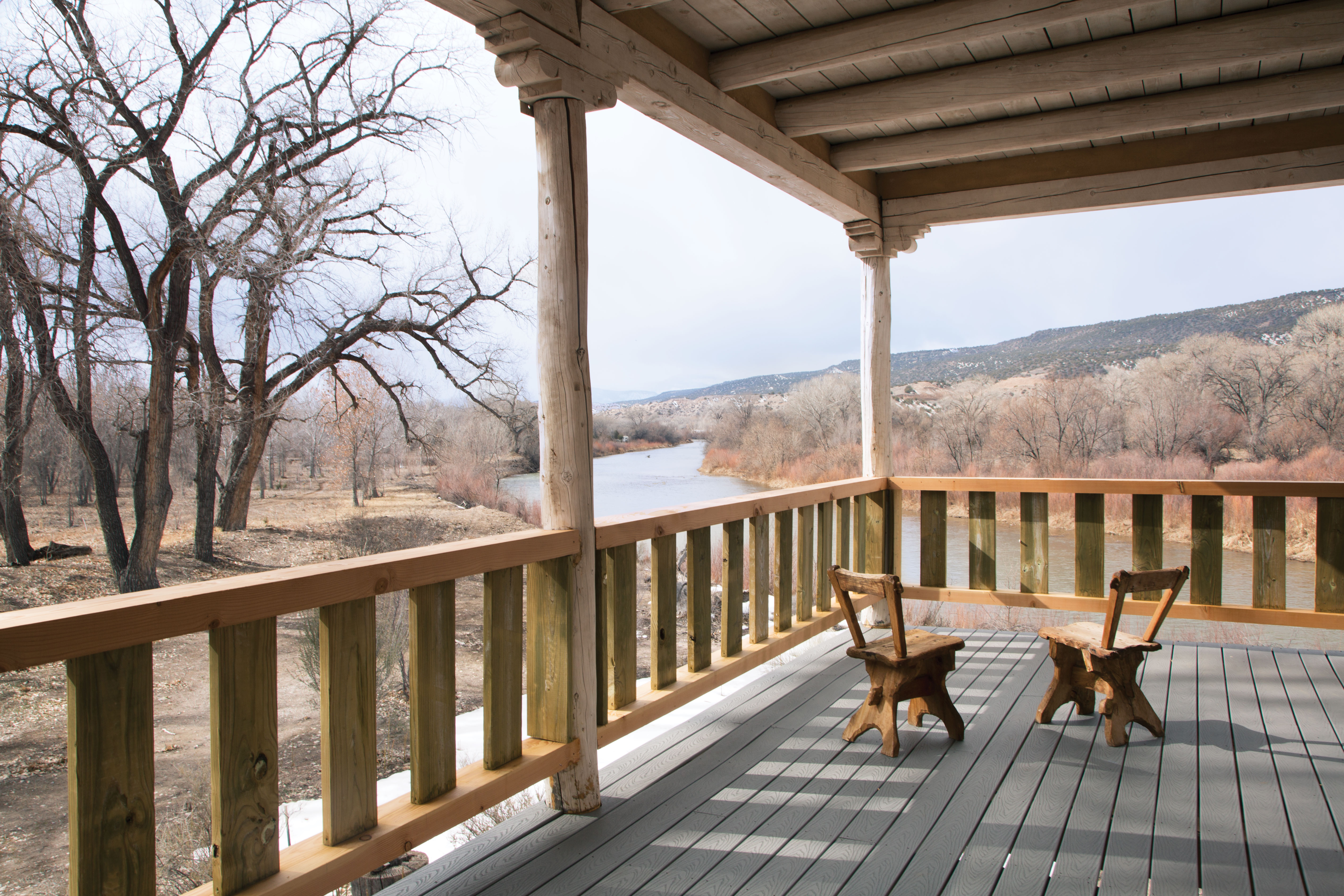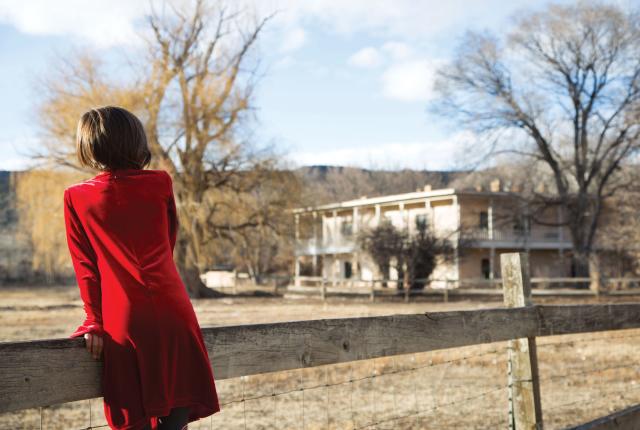Above: A young visitor catches a view of Los Luceros' historic hacienda. Photographs by Inga Hendrickson.
IT'S A CLOUDLESS SKY, a swath of uninterrupted blue that contrasts with the umber surroundings of nearly everything—the leftover alfalfa, dormant cottonwoods, and frozen ground. A couple of country dogs ramble around, and more than a few crows line the walls of family compounds along NM 41. On this tucked-away lane circling the northern New Mexico village of Alcalde, most private roads lead to dead ends and more dogs. It’s possible—probable, really—that you’ll miss the sign announcing the location of Los Luceros Historic Property.
A stretch of a 300-year-old acequia marks the eastern edge of Los Luceros, much like a seam. On one side, cholla cactus multiplies across dry patches of dirt, and on the other, verdant floodplains unfold. Dotting the 148 acres are a 19th-century hacienda and carriage house, an 18th-century chapel named the Capilla de la Sagrada Familia, deeded to the Archdiocese of Santa Fe in 1891, a Victorian-era bungalow called the Abel Lucero house, and the most recent addition, a two-story structure called the River House, built in 1992.
It’s an architectural bricolage.
“If only the walls could talk,” says groundskeeper Matthew Herrera with a slight Cheshire cat grin. Maybe Herrera’s pulling my leg by also mentioning that he’s felt a presence—a ghost?—in the hacienda, where stout hunter-green doors outfitted with metal grommets and heavy iron knockers give the ground floor the feel of a fortress. Some say there is a hanging tree nearby, he adds, where criminals captured by a 19th-century territorial sheriff saw their end. But which tree is up for debate. “It could be any of them,” he says, motioning from the interior of his truck to the thick arbor of cottonwoods lining the river like sentinels.
Los Luceros has been a fulcrum of activity since long before it took the name of a local and prominent family. First a Pueblo agricultural settlement, then the center of a Spanish colonial land grant, and later the home of an arts and culture doyenne, these fertile bottomlands have nurtured many. They’ve also been abandoned almost as much as they’ve been occupied. When the property thrived, it bustled with activity and agriculture. But in the stretches when owners were few and far between, adobe buildings caved under their own weight, acequias flooded, vandals came and went, and at least one grave was unearthed and sealed back up.
The New Mexico Department of Cultural Affairs purchased Los Luceros from the Cabot Foundation in 2008, making it the only state-run historic site or museum north of Santa Fe. Until then, the property had changed hands so many times in recent memory that most lost track.

Above: Ginny the burro, one of 20 animals on the property.
Maybe it was because proprietors came and went with such frequency that the broader community felt a sense of ownership—that it belonged to no one and everyone. Here, timelines, whether the official ones in print or the oral histories shared only among locals, tended to bleed together, tangling lore with facts, “all worthy of their own telling,” says Patrick Moore, director of New Mexico Historic Sites. History, in his opinion, “is messy, and ugly, and sometimes sticky.” But every story birthed from these lands deserves to be heard.
CARS WHIP BY ON NM 68, one of the most traveled tourist corridors in the state, or, as locals call it, the Low Road. It’s the second leg of a roughly straight shot from Santa Fe to Taos, by way of several pueblos, including Ohkay Owingeh, and the city of Española.
That same path, which runs parallel to the Río Grande, has always been an artery of commerce. It was one stop along the Old Santa Fe Trail and, before that, one of the final stops on El Camino Real. Ancestral Puebloans created the template for these networks centuries ago, with systems of exchange that stretched from the Pacific Coast to the Plains, down the Río Grande, and southward to present-day Mexico City.
Petroglyphs located upriver from Los Luceros, at Mesa Prieta, in Velarde, bear the imprint of an indigenous presence that goes back at least 10,000 years. Plains-style weapons, shields, armadillos playing the flute, turtles, and dogs are all etched into the dark rock faces in one of the largest concentrations of petroglyphs in New Mexico.
The fertile lands flanking P’osonghe (the Tewa name for the Río Grande) became the agricultural backyard of P’oyege, one of a grouping of Tewa communities (Sapawe, Ouinge, Ohkay Owingeh, and Yungue Owingeh) perched near the confluence of the Río Chama and the Río Grande. Potsherds floated downriver and into Los Luceros’ orchards and pasture, and when the road leading to the site was recently graded, more unglazed ceramics surfaced.
“Our goal is to tell the story of a contested space through the entire property, one that’s elsewhere been siloed,” says Moore. “Pueblo people and Spanish descendants both come to Los Luceros from a position of ownership.” To the Tewa, Los Luceros is one among a rich constellation of sites in their universe. To Spanish descendants, it’s a sacred slice of the Sebastian Martín Serrano Land Grant, a Spanish expanse established in the 18th century that spanned 50,000 acres.
Then there’s the Bostonian, Mary Cabot Wheelwright, founder of the Wheelwright Museum of the American Indian, with two-spirit medicine man Hostiin Klah, of the Navajo Nation. The property’s most renowned 20th-century proprietress, Wheelwright made a series of massive renovations to it between 1923 and 1958, when she died.
“Los Luceros was a safe haven for women like Wheelwright to get away from the gender stereotypes of the East Coast,” says Ethan Ortega, instructional coordinator of New Mexico Historic Sites. “It was a place where women could explore all of their identities.”
The hope, Moore says, “is that all these stories and more can rise to the surface.”

Above: Views from the deck of the River House.
UNTIL A COUPLE OF MONTHS AGO, the property was open only by appointment, for small tours, baby showers, and family reunions. For three years running, a fall Apple Harvest Festival brought upwards of 2,500 people. Birders considered it a regular haunt for spying a resident flock of sandhill cranes. At one point, a local Boy Scout troop came and helped clean the acequia. And many a northern New Mexican said their vows somewhere on its grounds.
Now Los Luceros is open four days a week, and visitors can tour the property and buildings, which are populated with period furniture from Wheelwright’s time and a set of frescoes she commissioned from painter Olive Rush. Moore has just acquired two period carriages for the carriage house as well. And the nearby barn is home to four lambs, two rams, five goats, and eleven ewes, in addition to the elder burro that keeps the coyotes away.
Some visitors bring a picnic lunch to eat by the river. Plein air painters set up easels. Birders pull out binoculars. Others can stop by the capilla and revel in the carved doors, originally whittled in the 1860s by one Gregorio Ortega, of Truchas, for the Peñasco home of Policarpio Romero, and later transferred to Alcalde. Or peek inside where local santera Claire Villa painted and installed a reredo (altar screen) during a renovation in the early 2000s. Others still can discover one of the largest mulberry trees in New Mexico next to the Abel Lucero house.
While the site is still a “work in progress,” according to Los Luceros’ site manager, Susan Mikkelson, the potential is endless. Her enthusiasm for the future, like Moore’s, is infectious. They both speak about the property’s prospects as if already fully actualized, even as the day-to-day challenges of getting it up and running have included, for instance, vaccinating the lambs. There’s also the task of getting the recently constructed commercial kitchen recertified. Then they plan to lease out plots of land to local gardeners and ranchers, making it a usable community resource, as it has been at various points in its long life.
And before spring is out, the New Mexico Acequia Association will establish its office on-site. The famed Los Luceros acequia is within walking distance.
Moore says that each one of the hacienda’s rooms will soon house exhibits on all of these eras, and those less associated with Los Luceros proper, too, like the history of Native slavery, the Manhattan Project, and the land grant wars of the 1960s.
“Those rooms,” he says, “already hold the shadows of many pasts.”

A BRIGHT FUTURE
Los Luceros Historic Property, west of NM 68 in Alcalde, is open Thursday through Sunday, 10 a.m.–5 p.m., or by appointment. Special-event rentals are available (505-476-1165, nmmag.us/losluceros).
Upcoming events at the site include a “Nature and Culture” series:
- April 28: Sheep shearing with Española Valley Fiber Arts
- May 18: Pollinators’ introduction to beekeeping
- May 25: No Labels Necessary, a panel discussion on the queer history of Los Luceros
- July 20–21: Two-part horno-building workshop
- August 10: Third (final) horno-building workshop
- September 28: Fourth annual Apple Harvest Festival
LEARN MORE
Read Los Luceros: New Mexico's Morning Star (Museum of New Mexico Press, 2018).


